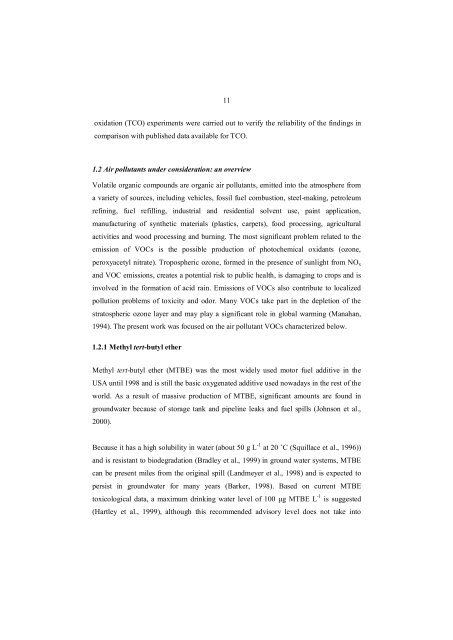gas-phase photocatalytic oxidation of volatile organic ... - Doria
gas-phase photocatalytic oxidation of volatile organic ... - Doria
gas-phase photocatalytic oxidation of volatile organic ... - Doria
You also want an ePaper? Increase the reach of your titles
YUMPU automatically turns print PDFs into web optimized ePapers that Google loves.
11<br />
<strong>oxidation</strong> (TCO) experiments were carried out to verify the reliability <strong>of</strong> the findings in<br />
comparison with published data available for TCO.<br />
1.2 Air pollutants under consideration: an overview<br />
Volatile <strong>organic</strong> compounds are <strong>organic</strong> air pollutants, emitted into the atmosphere from<br />
a variety <strong>of</strong> sources, including vehicles, fossil fuel combustion, steel-making, petroleum<br />
refining, fuel refilling, industrial and residential solvent use, paint application,<br />
manufacturing <strong>of</strong> synthetic materials (plastics, carpets), food processing, agricultural<br />
activities and wood processing and burning. The most significant problem related to the<br />
emission <strong>of</strong> VOCs is the possible production <strong>of</strong> photochemical oxidants (ozone,<br />
peroxyacetyl nitrate). Tropospheric ozone, formed in the presence <strong>of</strong> sunlight from NOx<br />
and VOC emissions, creates a potential risk to public health, is damaging to crops and is<br />
involved in the formation <strong>of</strong> acid rain. Emissions <strong>of</strong> VOCs also contribute to localized<br />
pollution problems <strong>of</strong> toxicity and odor. Many VOCs take part in the depletion <strong>of</strong> the<br />
stratospheric ozone layer and may play a significant role in global warming (Manahan,<br />
1994). The present work was focused on the air pollutant VOCs characterized below.<br />
1.2.1 Methyl tert-butyl ether<br />
Methyl tert-butyl ether (MTBE) was the most widely used motor fuel additive in the<br />
USA until 1998 and is still the basic oxygenated additive used nowadays in the rest <strong>of</strong> the<br />
world. As a result <strong>of</strong> massive production <strong>of</strong> MTBE, significant amounts are found in<br />
groundwater because <strong>of</strong> storage tank and pipeline leaks and fuel spills (Johnson et al.,<br />
2000).<br />
Because it has a high solubility in water (about 50 g L -1 at 20 �C (Squillace et al., 1996))<br />
and is resistant to biodegradation (Bradley et al., 1999) in ground water systems, MTBE<br />
can be present miles from the original spill (Landmeyer et al., 1998) and is expected to<br />
persist in groundwater for many years (Barker, 1998). Based on current MTBE<br />
toxicological data, a maximum drinking water level <strong>of</strong> 100 �g MTBE L -1 is suggested<br />
(Hartley et al., 1999), although this recommended advisory level does not take into

















